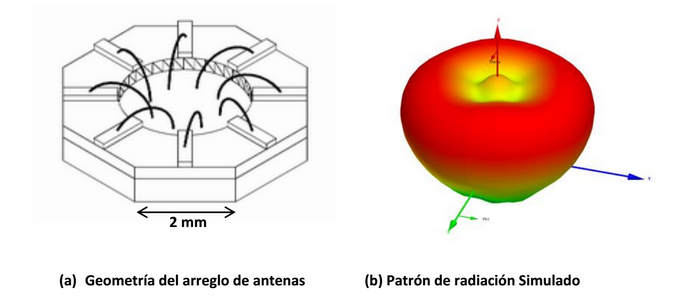University of Chile announce a WiFi patent
Wednesday, May 28, 2014
A group of researchers from the Department of Astronomy (DAS) at the University of Chile, presented a request for the protection of intellectual property for the new design and construction of high-frequency antennas developed by the Laboratory of millimeter waves.
The invention relates to an antenna of very small size for communications in the 60 GHz band, which is built using the symmetrical arrangement of loops of micro-gold wires (bond wires). This is known as an array of antennas in phase (phased array) and can be inserted within integrated circuits (IC, chips).
Ricardo Finger, professor of the DAS and leader of the team of investigators explains that "all the factories that produce integrated circuits need to make connections within the microscopic chips. Those connections are created with a gold wire too thin in the form of loop or loop, and it is conducted by a special machine that, until now, I only had that function".
However, in recent years the idea arose that these loops of gold could also be used as antennas and not only as connecting cables. "This project was very attractive because the machinery is already installed in the business of production of microchips and in all the laboratories that do this, and be able to reuse that capacity of a novel way can be very useful," says Finger.
To do this, the researchers created a combination of micro gold wires, which are fed with wave guides (a kind of copper track) that carry the signal to the loops in a synchronized manner, allowing all act as if they were only one antenna.
The great advantage of the new technology is that operates at frequencies around 60 GHz which does not need a license (permission) for operation, equivalent to the WiFi systems that operate in the 2.4GHz band, but with much more capacity of data transfer.
"This technology can be applied, for example, for the replacement of cables in digital television or professional audio. If these electronic equipment have this connectivity, one does not need any cable to connect. Then you may have your music equipment connected to the computer and the TV without the need of cables. Currently, it is possible to achieve something similar using WiFi, but the wireless communication is not capable of transmitting high-definition television (full HD, 4K), especially when the images change rapidly, something that if it is possible to 60 GHz with our antenna," he says.
The team of researchers is also integrated by Rick Van Kemenade, student of Magister of the University of Eindhoven (The Netherlands); Claudio Jarufe, Phd student in Electrical Engineering from the University of Chile; and Leonardo Bronfman, astronomer and academic at the University of Chile. This work was made possible thanks to financial support and infrastructure of the Center for Astrophysics and Related Technologies CATA-Basal.
 |




